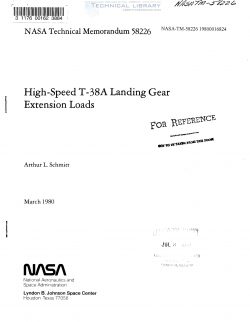NASA-TM-58226
- Version
- 70 Downloads
- 522.18 KB File Size
- 1 File Count
- May 10, 2017 Create Date
- May 10, 2017 Last Updated
High Speed T-38A Landing Gear Extension Loads

A series of high—Speed landing gear extension flight tests was conducted
at the NASA Lyndon B. Johnson Space Center with a T—38A aircraft. The objec—
tive of the flight tests was to determine the maximum safe airspeed at which
the T—38A landing gear could be extended at high altitude (12 192 meters
(40 000 feet)), for the purpose of planning Space shuttle chase missions.
The flight-test reSults indicate that both altitude and airspeed affect
landing gear extension loads. A safe landing gear extension speed limit at
low altitude will not necessarily be a safe limit at high altitude. Aero—
dynamic forces apparently cause high landing gear extension loads, and flight-
test results prove that these forces can be controlled to within acceptable
limits with strut-door flaps.
Flight plans for the first few Space Shuttle missions require a chase
aircraft during the final portions of the return trajectory. The chase air-
craft, a T—38A, will rendezvous with the returning Space Shuttle at 10 668 to
12 192 meters (35 000 to 40 000 feet) altitude and follow the Space Shuttle
during its descent while providing assistance to the pilot and photographing
the Space Shuttle return. However, the chase mission poses a technical prob-
lem for the T-38A chase aircraft. The landing gear must be extended while
flying very high and very fast to provide the necessary aerodynamic drag to
stay with the Space Shuttle on its steep return glidepath. The maximum land—
ing gear extension speed for a T-38A is normally 123 m/s (240 knots indicated
airspeed (KIAS)), but the chase-aircraft landing gear must be extended at
Speeds as great as 144 m/s (280 KIAS corrected for instrument and position
error (KCAS)), and at altitudes as high as 12 192 meters (40 000 feet). To de-
termine the maximum airspeed at which the T—38A landing gear could be extended
for the chase missions, a flight-test program was conducted at the NASA
Lyndon B. Johnson Space Center.
In compliance with the NASA's publication policy, the original units of
measure have been converted to the equivalent value in the Systeme Interna-
tional d’Unites (SI). As an aid to the reader, the SI units are written
first and the original units are written parenthetically thereafter.
| File | Action |
|---|---|
| NASA-TM-58226 High Speed T-38A Landing Gear Extension Loads.pdf | Download |

Comment On This Post